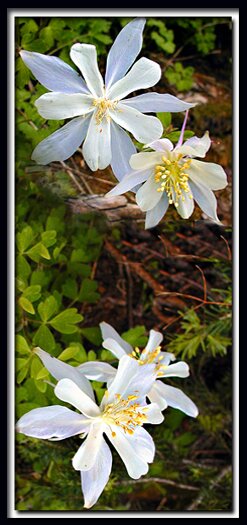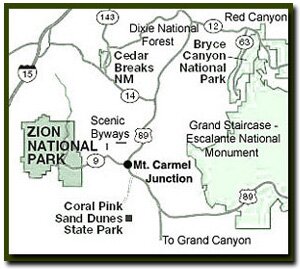 |
||||
|
Cedar Breaks Lodging Camping SR 148 SR-14 Hike Backpacking Vacation DNF Pictures Area Weather |
||||
|
|||||||||||||
Directions to Cedar BreaksU-148 Closure Dates. U-148 to Cedar Breaks closes in the winter due to snow depth. From Las Vegas: Take I-15 north to Cedar City. Take U-14 east from Cedar City to U-148 and turn left to Cedar Breaks. Cedar Breaks Road Map - Cedar Mountain Map 
|

|
|||
|
|
||||
The "Perfect" Christmas Tree
The Engelmann spruce is an evergreen found at Cedar Breaks, but the beetles are destroying them. With the end of the drought now a hopeful reality, the surviving Engelmann spruce might have a chance to live. If not the forest will become a huge aspen forest. This spruce is the "traditional" Christmas Tree, due to it's well formed shape and beauty. The cones are at the top of the tree and hang down.
Cedar Breaks National Monument is surrounded by Utah's Dixie National Forest. From Mt. Carmel Junction, drive north on US-89 to the junction with SR-14. SR-14 is known as Cedar Mountain which is the scenic byway to travel to Cedar Breaks. Once on Cedar Mountain, travel through the beautiful forest, and then turn at the signed highway to Cedar Breaks - SR-148. It's 22 miles from Mt. Carmel Junction to boundary of Dixie National Forest and 45 miles to Cedar Breaks.
Utah's Dixie National Forest: Red Canyon
Red Canyon is a unique part of Dixie National Forest that is not only traveled through on the way to Bryce Canyon, but it has eroded hoodoos like Bryce Canyon and Cedar Breaks. It is found along Scenic Byway 12.
|
|
Cedar Breaks National Monument, Utah
East Zion Lodge
Vacation House
Group Lodging
East Zion Golf
East Zion RV Park
Vacation Packages
Business Retreat
Mileage from
Mt. Carmel Jct.
Zion National Park 12
Bryce Canyon 60
Grand Canyon 85
Cedar Breaks 45
Grand Staircase 9
Dixie Forest 22
Sand Dunes 11
Coyote Butte 57
Red Canyon 47
Tuweep 90
Stay in the heart of the parks, Mount Carmel Junction, and visit the treasures of the Southwest and Utah.
Site Map
Site Map II
Site Map III
Hiking Trails
Bartizan Arch
Spectra Point Trail
Ramparts Trail
Easy Trails
Cascade Falls
Bristlecone Pine
Alpine Pond
Cedar Breaks info
Visitor Center
Fees and passes
Ranger programs
Kid activities
History
Fauna
Flora
Cedar Breaks maps
"I don't know who Mary Cisneros is, but I mean zionnational-park.com
It's a better site than the NPS's anyway."
Written by the authors of the book: Favorite Hikes in and around Zion National Park
Contact Mary to report errors:
|
Zion History |
|---|
All rights reserved © Copyright Zion National-Park dot com
Do not use text, photos or maps without permission © Zion National-Park dot com
Contact the Author Mary Cisneros



 Bristlecone Pine Trees
Bristlecone Pine Trees
